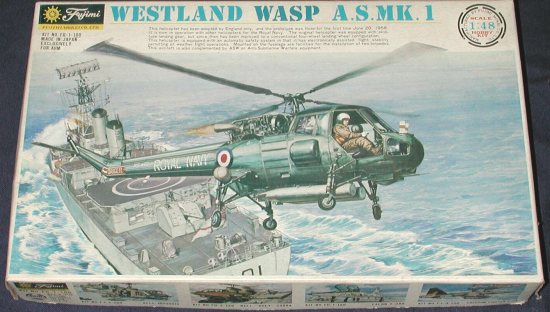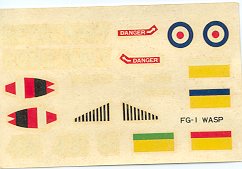
|
KIT: |
Fujimi 1/48 Westland Wasp AS.1 |
|
KIT # |
FG-1 |
|
PRICE: |
$1 when it was new about 30 years back! |
|
DECALS: |
One aircraft |
|
REVIEWER: |
|
|
NOTES: |
AHM boxing |

|
HISTORY |
|
THE KIT |

Molded in a very dark blue plastic, this kit is undoubtedly from the early 1970s or perhaps late 1960s, when Fujimi kits were imported by AHM as the instructions are in English. Just to let you know how old it is, the MSRP of it on the box is $1. The level of molding is excellent with finely raised detail and rivets. The plastic is a bit thick as was the norm for Japanese kits of that era. The rivets are also very much in scale as helos don't usually do the flush rivet thing. No need for something that travels at such slow speeds. While there is some flash on parts, they are devoid of sink areas and ejector pin marks in the wrong place. A rather complete cockpit is provided with seats, instrument panels and a single cyclic control. No collective is provided, but there is a nice jump seat in the back. If you are wondering why the bulges on the side of the back doors, that is so a stretcher can be carried.
The clear plastic bits are rather thick, and somewhat distorted. There
is a relatively well done engine and the rotor head is convincing.
Unfortunately, part of mine has some broken parts that will need repaired
before construction. The blade attachment points are usually fragile on
helo kits and this one is no exception. A well done undercarriage is
provided as are a pair of torpedoes, the usual armament of an ASW helo.
Fortunately, the attachment points for these torpedoes are benign so you
can leave them off with no filler necessary. Two crew members are also provided if you want your Wasp occupied.
members are also provided if you want your Wasp occupied.
Instructions are typical of the older style with several exploded drawings and a step by step written construction sequence. Only one set of decals is provided and that for a very generic Wasp. Due to the age of the kit and the conditions under which it was stored, the decals on this kit do not appear to be viable any longer. However, thanks to the generic markings, replacing them from letter/number decal sheets shouldn't be a problem. Same with the roundels and Royal Navy markings. There is no specific decal placement guide, that information being provided in the construction drawings.
|
CONCLUSIONS |
Overall, it looks like a nice kit that should build up into a fair model of the type. To my knowledge, the only other Wasp kit is the equally as ancient Airfix kit, though undoubtedly a Helo fan out there will let me know the error of my ways if I'm mistaken!
Review kit courtesy of me.
If you would like your product reviewed fairly and fairly quickly by a site that has 200,000 visitors a month, please contact me or see other details in the Note to Contributors.